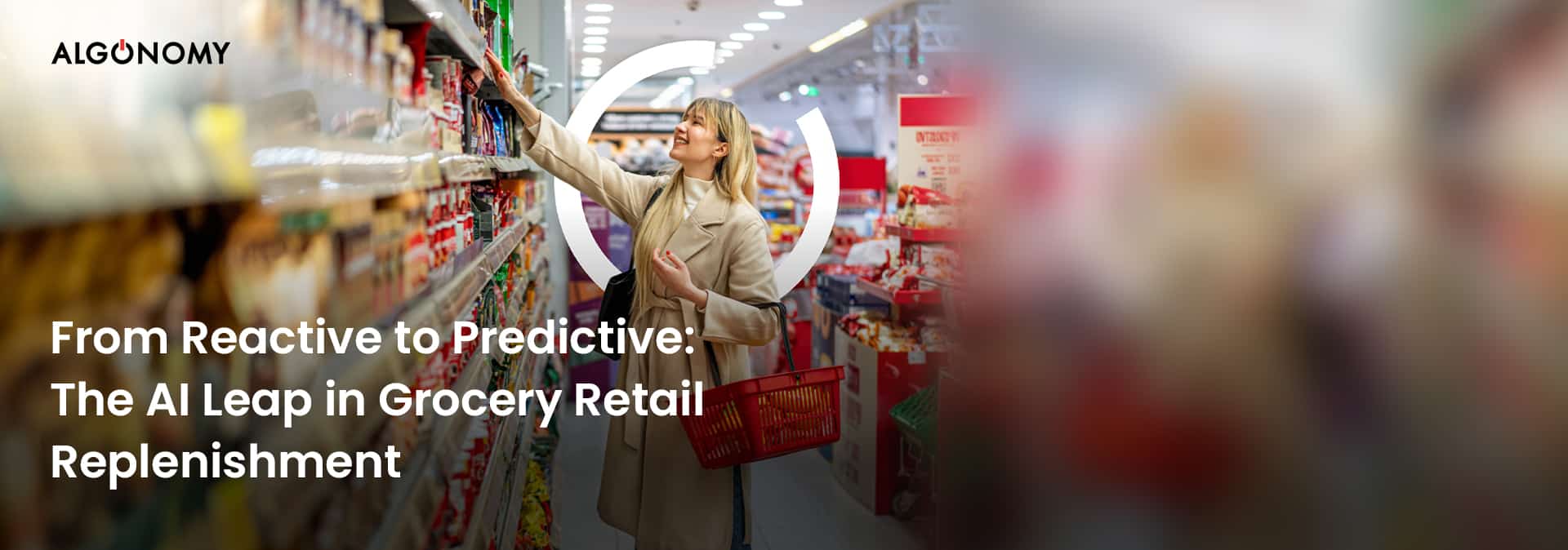The gap between “digitized” and “intelligent” replenishment is where millions in revenue, customer loyalty, and operational efficiency are won or lost. Whether your grocery store replenishment is going to be a tale of success or a saga of misery from wastage or losses hinges on the accuracy of your forecasts and the adaptability of your order plans.
Many grocery retailers believe that replacing manual number-crunching with an inventory management system is the ultimate hack to cut stock issues, reduce waste, and unlock millions in savings. In reality, replenishment is far more intricate and influenced by complex variables, like volatile demand patterns, promotional demand fluctuations, supply chain disruptions, and ever-changing consumer preferences.
Moving from reactive number-crunching to predictive, AI-driven replenishment isn’t just an upgrade; it’s the new competitive baseline for grocery retailers.
Overlooking the Step Zero
Retailers may collect mountains of data, which is critical for demand and replenishment planning. But because the data is highly unstructured and riddled with gaps or noise, traditional modeling methods tend to over-engineer corrections, distorting the demand signals or discarding “problematic” inputs entirely, leaving critical demand insights on the table.
This snowballs into erroneous forecasts, faulty replenishment, and ultimately stock imbalances across all store locations, driving loss, wastage, and capital lock-ins.
This is exactly where AI-led demand modeling kicks off the transformative leap in forecasting accuracy and replenishment automation.
Instead of handling data noise and sparsity as exceptions, it automatically detects outliers and models demand at an ultragranular level, think SKUs and store location combinations, instead of category or sub-category level modeling.
Getting Equipped for Scale and Complexities
Thousands of SKUs across hundreds of store locations make the grocery store replenishment a massive puzzle of scale and complexity. Standard demand modeling approaches are static rule-based, meaning they can neither identify nor plan for demand dynamics for similar or different SKUs at different store locations.
Further, the actual grocery store sales are hugely influenced by external factors, such as holidays, festivals, seasons, weather, and promotions. AI-led demand forecasting and replenishment naturally incorporates all these influencers as variables and models demand for all SKUs and store location combinations, achieving hyperlocal stock precision, something that is beyond the scope of traditional tools.
Understanding Promotional Demand and Its Impact
One of the most critical aspects of in-store promotions is often overlooked and unaccounted for in traditional demand planning and replenishment scenarios. While they plan for demand “lifts” that are expected during promotions, they tend to overlook any kind of demand “shifts” that might happen due to promo-induced demand fluctuations.
Let’s zoom out on this.
A top-seller during promotions also draws demand away from the regular performer on the shelves (same or different category). Inability to account for such demand shifts can not only cause overstock of non-promoted items, but also make promoted items go out of stock.
Projecting the problem over hundreds of stores gives a reality check of how food and grocery retailers miss out on promotional gains despite planning for them in the first place.
AI-led promotional planning accounts for both demand shifts and lifts for each SKU-store combination, offering highly precise order plans that ensure stock balance, minimize wastage due to overstocking, and boost promotional revenue.
Interface Switching for Vendor and Supply Variations
Grocery retailers are working with multiple service providers and vendors at a time. This means they are switching among multiple management software or interfaces. Now, despite having the automation at their disposal, the inability to integrate supply and vendor-side factors with demand planning and replenishment systems renders it inefficient.
Standard, one-size-fits-all inventory planning systems plan for days of stock, safety stocks, etc. They don’t allow retailers to actually input supply and vendor-side variables, like supply calendars, blackout days, local holidays, fill rates, etc., for optimizing the order plans for each location.
On the other hand, AI-driven demand planning and replenishment inherently factor in all such variables, ensuring a highly robust, wholesome, and reliable replenishment planning that adapts to the supply chain realities.
Siloed Planning Across Warehouse, Distribution Centres, and Stores
Another bottleneck for grocery retailers is the inability to look beyond the store inventory during replenishment planning. This gives a siloed view of store-level inventory, while stock could be languishing across warehouses, distribution centres, or dark stores.
AI-led demand planning and replenishment automation consider inventory at all locations, and help optimize stock for direct-to-store orders, warehouse orders, DC orders, and so on. Hence, retailers can unlock holistic inventory optimization, which reduces stock imbalances, boosts inventory turnover, and minimizes wastage.
The Takeaway
The exhaustive planning and modeling superiority deliver both strategic resilience and near-term ROI, stemming from the unparalleled computation power of AI-led demand planning and auto-replenishment frameworks.
Be it the agility and demand modeling finesse required for an uncertain market, or sustainability goals, be it multi-format retailing or improvements in margins – AI-led solutions deliver across all business goals, setting them class apart from traditional systems and the game-changers in modern grocery retail.
 in Sweden from 7 - 8 October 2025. Pre-book a meeting to connect with our
product experts.
in Sweden from 7 - 8 October 2025. Pre-book a meeting to connect with our
product experts.










